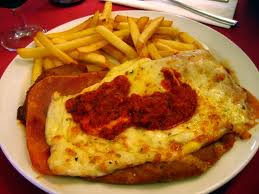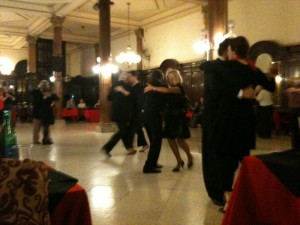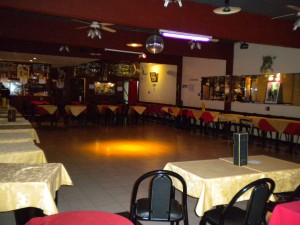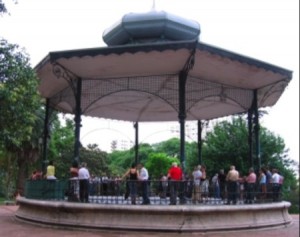A few hundred people surrounded the cleared dance floor, watching an intertwined couple dance lustfully to the music. The female dancer twirled in a gossamer two-piece outfit of blues and purples that bared her midriff; her wide eyes remained closed as her partner led. At moments during the ever-graceful, ever-charged tango performance, it looked like they were moving as one.Unlike the tango that is packaged for tourists in dinner shows across Buenos Aires, the couple’s four-song performance took place in the main room of the Villa Malcolm recreation centre (Cordoba 5064; 47-72-9796), surrounded by an audience of other tango dancers. Upstairs, out of earshot, teenage boys played on indoor fútbol fields, and near the entryway to the cavernous dance room, staff members served empanadas and classic Argentine milanesas, breaded, fried meat filets, straight from the grill.
After the touristy dinner shows conclude each night, the professional tango dancers, some with stage makeup still caked on, migrate to community centres, dance halls and recreational facilities across Buenos Aires to join the masses in any one of multiple milongas or prácticas taking place. The milonga — essentially any place or event where people gather to dance tango — is where the history of the dance meets its future, where the nostalgic sounds of accordions blend with the rejuvenating energy of youth, and where the most seasoned dancers share the dance floor with novices. Milongas bring together a cross-section of all walks of life: local, international, young and old.
This underground, nocturnal world of tango offers the purest way for visitors to experience the dance. At its roots, tango is not a choreographed performance. Though most milongas do include an impressive invitational performance from professional dancers mid-way through the evening, the dance floor is open for improvisation the rest of the night.
The vast majority of milonga attendees are serious about learning or perfecting the tango, though no skill level is required to attend. Additionally, most milongas begin the night with a lesson. Non-dancers are welcome to sit at any one of the tables that ring the dance floor, order a bottle of wine and observe the throngs of couples tangoing. As opposed to a dinner show, which costs hundreds of Argentinean pesos, entrance to a milonga ranges between 15 and 30 pesos.
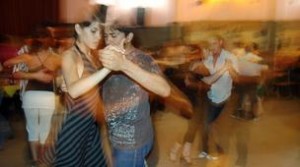 Couples dance the tango at Villa Malcolm’s Monday night milonga in Buenos Aires
Couples dance the tango at Villa Malcolm’s Monday night milonga in Buenos Aires
“This is the real tango, ” said Gabrielle Stein, a professional tango dancer and guide for Narrative Tango Tours, which takes small groups of no more than six people on private tours to milongas around the city. Stein teaches the groups about the history, culture and social codes of the tango, and shares her own experiences of learning and dancing it.
Narrative Tango Tours often takes visitors to one of the most revered milongas in the city, Milonga Parakultural, which takes place three days a week at the historic dance hall Salón Canning. On a recent Friday night in the lit, high-ceilinged room, men lined the carved, wooden bar, scouting out their next dance partners. Those who had already paired off filled the dance floor. True to the mixed crowd of a milonga, a man who at first glance appeared too frail to walk was one of most skilful and desired dancers of the night; he was never without a partner.
Club Fulgor (Loyola 828; 15-4066-5831), in the Villa Crespo neighbourhood, is a small venue compared Villa Malcolm and Salón Canning. The tango practiced at Club Fulgor’s Praktika 8 or Milonga10 on Tuesday and Saturday nights is contemporary, with high kicks and fancy twists, and showier than the more traditional style seen at Salón Canning. On one Tuesday night, a dancer in attendance had competed in the Tango World Cup in August.
Some of the city’s top tango dancers also regularly take to the floor at La Viruta, an unpretentious space below an Armenian cultural centre in the Palermo neighbourhood. The hall hosts tango classes six days a week, with most ending in a práctica, as well as other dance classes, such as salsa.
One of the most unexpected milonga spots in Buenos Aires is in a sizable, lit gazebo in the sloping park facing the Belgrano C train station. The free milonga La Glorieta, gets started around 7 pm, much earlier than most other milongas in the city.
Karina Martinez-Carter
23 Nov 2011
http://www.bbc.com/travel/feature/20111121-the-tango-buenos-aires-tourists-never-see
